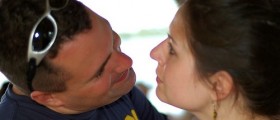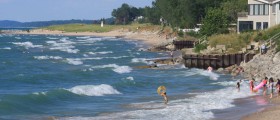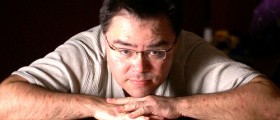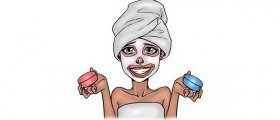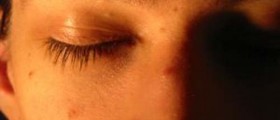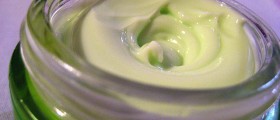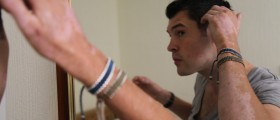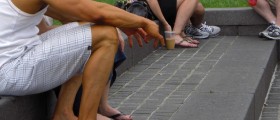Loading...
I would offer that there is insufficient metabolism of your food, and that your gall bladder and liver could be sluggish. You may know that your liver must filter everything that you come into contact with, food, water, alchohol, air pollution, your pharacuetical medicatation, etc. This can create a back up that the skin then has to work harder to excrete. It could be excess sebum clogging your pores as a result of the sluggish liver and congested gallblader. Topically speaking, have you gone to a holistic estechian and received a deep cleaning facial and used subltle exfoliation such as prune or fruit masks? I do not know about the condition you mentioned. I would get a second oponion about the fosamax and start eating mineral and calcium rich foods such as quality kelp,( or seaweed salad as found in japanese restaarants) dark leafy greens,( kale, collards, mustard greens, more kale) if you eat spinach, use vinegar on it to make it more bioavaible) sesame seeds, tahini ( sesame seeds ground to a paste) Add herbs that can move the gallbladder and liver and then clear the lymph and of course work on removing toxins held in the colon-- gently gently.
Dr Hauskha ha is a natural skin care line.They make a mask called rejuvinating mask that is suppossed to help the body reabsorb hardened skin like your bumps.
no spell check - please excuse the spelling errors
Loading...
Loading...
by Naweko San-Joyz
Are you making these mistakes each time you spot a little white little bump on your face? Fixing those little white bumps starts with a small dose of education and ends with a big dose of prevention. After understanding the five reasons below, your little bumps should give way to clearer skin.
Reason #1: You have no clue what those little white bumps are anyway.
Little white bumps, or milia, are keratin-filled cysts, or simply little globs of protein under the skin. There are generally two types of milia. Primary milia may result from oil glands that have not fully or properly developed. Secondary milia result from trauma to the skin.
Reason #2: You think all little white bumps are acne, and treat them that way.
Just because you have little white bumps on your face does not necessarily mean that you have acne. Milia, are little balls of protein beneath the skin that do not have a pore, or hole in the skin through which to escape.
Comedones or whiteheads are excess fats and wastes that are trapped in a hair follicle and so they clog up the pore. In short, milia are proteins trapped within the skin, while comedones are fats and skin debris trapped within the pore.
Exfoliating the skin, or removing the dead skin cells from your skin with an abrasive product or chemical, is beneficial. But brutally scrubbing your face with soaps and chemicals too frequently may actually create milia. To avoid this, remember that gentle exfoliation helps prevent excess dead skin cell build-up that could clog your pores and cause whiteheads, not milia.
This gentle exfoliation helps make eventual removal of the milia easier because the skin layer around the milia becomes thinner, with frequent, yet gentle exfoliation. In short, Exfoliate your skin to prevent milia, not to cure them.
Reason # 3 You have no idea what causes those little white bumps anyway.
When you were a baby, you were probably covered with milia that disappear after a few days. Or, you may have inherited milia from your parents.
On the other hand, you may develop milia after excessive exposure to the sun. The reasons for developing milia after sun exposure are debatable. According to some studies, the active ingredients sunscreens like Parsol 1789 may cause sun allergies and later lead to a milia breakout. Other studies blame the sun itself for “damaging” the skin can thus causing little white bumps.
Some people experience milia around the mouth. This could be the result of fluoride irritation from toothpaste.
Reason # 4: No one ever told you how to prevent milia.
The best way to prevent milia is to avoid treating your skin with excessively harsh chemicals and to limit sun exposure.
To reduce creating milia around the eyes, use eye creams with the least amount of ingredients possible to avoid irritating the delicately thin eye area. Also, gently touch the eyes and avoid rubbing the eyes vigorously so as not to damage the skin.
When brushing you teeth, try to keep the pasty foam from staying around your mouth too long. This limits possible fluoride irritation to the skin.
Use a sunscreen with the least amount of ingredients. Extraneous ingredients like fragrances may irritate your skin. Additionally, purchase sunscreens that offer physical sun blockage that contain active ingredients like titanium oxide or zinc oxide.
Reason #5: You still want to know what you can do right now to get rid of milia.
The key to getting rid of milia is realizing that they have no escape route, those little bumps are trapped under the skin. So, to get them out, you’ll need to have a professional like a dermatologist or aesthetician extract them. You can extract the milia yourself, but this involves risks.
Precautions You need to ensure that you milia are not symptoms of some underlying disease or illness. Also, if you extract the milia yourself, you may have trouble completely pulling out the cysts, as the removable process may prove too painful.
Otherwise, if you are confident with your health and courage, you can cleanse your hands and face. Then wet a cloth with warm water and apply it to your face for a few minutes. Gently apply a sterile needle to the center of the little white bump to create a tiny opening in the skin.
Wrap your thumbs in a clean tissue and, using your thumbs, proceed to gently squeeze the contents of the little white bump out. Finally, cleanse the area of the extracted little white bump with an astringent.
Now, you have no reason to walk around with little white bumps on your face. If you still think you do, please consider the possibility that you’re just telling yourself little white bumpy lies.
Loading...
water causes milia: milia is skin debris from ingestion of hard
mineral (heavy metals) ingestion and it's aggravated by
any topical blockage caused from hard mineral water
exposure. Exposure to sunlight drastically helps the
skin get--expire--rid of hard mineral deposits in
the dermal and epidermal layer of skin...
If not for sun exposure, a person would
eventually die (terminate) from heavy
metal build-up in the skin (by a failure
to be able to respirate).
Sun exposure initially exemplifies--bad calcium and magnesium consumption or 'age spots' and wrinkling like a cow hide as the skin cleans out the dietary debris--the poor nutrition of diet containing too much bad (cheese) calcium, etc. One looks rather worse before getting better, as with a chemical or lazer peel... The problem: how long as the person ate so badly? How much debris: can the debris be worked off the surface of the skin? What are the exercise and behavioral habits?
One thing for certain: the skin as an organ evolved out of people getting about 5-6 hours of direct (as in naked with only mud and leaves) sunlight exposure daily; milia is only aggravated by not enough sunlight--dirt, sand, sun and surf, etc.--exposure.
Guest wrote:
Five Reasons Little White Bumps Are On Your Face and How to Get Rid Of Them
by Naweko San-Joyz
Are you making these mistakes each time you spot a little white little bump on your face? Fixing those little white bumps starts with a small dose of education and ends with a big dose of prevention. After understanding the five reasons below, your little bumps should give way to clearer skin.
Reason #1: You have no clue what those little white bumps are anyway.
Little white bumps, or milia, are keratin-filled cysts, or simply little globs of protein under the skin. There are generally two types of milia. Primary milia may result from oil glands that have not fully or properly developed. Secondary milia result from trauma to the skin.
Reason #2: You think all little white bumps are acne, and treat them that way.
Just because you have little white bumps on your face does not necessarily mean that you have acne. Milia, are little balls of protein beneath the skin that do not have a pore, or hole in the skin through which to escape.
Comedones or whiteheads are excess fats and wastes that are trapped in a hair follicle and so they clog up the pore. In short, milia are proteins trapped within the skin, while comedones are fats and skin debris trapped within the pore.
Exfoliating the skin, or removing the dead skin cells from your skin with an abrasive product or chemical, is beneficial. But brutally scrubbing your face with soaps and chemicals too frequently may actually create milia. To avoid this, remember that gentle exfoliation helps prevent excess dead skin cell build-up that could clog your pores and cause whiteheads, not milia.
This gentle exfoliation helps make eventual removal of the milia easier because the skin layer around the milia becomes thinner, with frequent, yet gentle exfoliation. In short, Exfoliate your skin to prevent milia, not to cure them.
Reason # 3 You have no idea what causes those little white bumps anyway.
When you were a baby, you were probably covered with milia that disappear after a few days. Or, you may have inherited milia from your parents.
On the other hand, you may develop milia after excessive exposure to the sun. The reasons for developing milia after sun exposure are debatable. According to some studies, the active ingredients sunscreens like Parsol 1789 may cause sun allergies and later lead to a milia breakout. Other studies blame the sun itself for “damaging” the skin can thus causing little white bumps.
Some people experience milia around the mouth. This could be the result of fluoride irritation from toothpaste.
Reason # 4: No one ever told you how to prevent milia.
The best way to prevent milia is to avoid treating your skin with excessively harsh chemicals and to limit sun exposure.
To reduce creating milia around the eyes, use eye creams with the least amount of ingredients possible to avoid irritating the delicately thin eye area. Also, gently touch the eyes and avoid rubbing the eyes vigorously so as not to damage the skin.
When brushing you teeth, try to keep the pasty foam from staying around your mouth too long. This limits possible fluoride irritation to the skin.
Use a sunscreen with the least amount of ingredients. Extraneous ingredients like fragrances may irritate your skin. Additionally, purchase sunscreens that offer physical sun blockage that contain active ingredients like titanium oxide or zinc oxide.
Reason #5: You still want to know what you can do right now to get rid of milia.
The key to getting rid of milia is realizing that they have no escape route, those little bumps are trapped under the skin. So, to get them out, you’ll need to have a professional like a dermatologist or aesthetician extract them. You can extract the milia yourself, but this involves risks.
Precautions You need to ensure that you milia are not symptoms of some underlying disease or illness. Also, if you extract the milia yourself, you may have trouble completely pulling out the cysts, as the removable process may prove too painful.
Otherwise, if you are confident with your health and courage, you can cleanse your hands and face. Then wet a cloth with warm water and apply it to your face for a few minutes. Gently apply a sterile needle to the center of the little white bump to create a tiny opening in the skin.
Wrap your thumbs in a clean tissue and, using your thumbs, proceed to gently squeeze the contents of the little white bump out. Finally, cleanse the area of the extracted little white bump with an astringent.
Now, you have no reason to walk around with little white bumps on your face. If you still think you do, please consider the possibility that you’re just telling yourself little white bumpy lies.
Loading...
take a very hot washcloth and put it over the calcium deposit for as long as you can stand it. then, take a small pin and place it in rubbing alcohol. place the pin around or on top of the calcium deposit. this is when you have to basically try to dig it out. eventually, a hard looking almost like a grain of sand will come out. you may experience a little bit of blood.
this is for small calcium deposits. the quicker you notice the small white bumps on your face, the faster you want to can't rid of them! they will become larger.
hope this helps! but i am not a doctor...haha.
Loading...
Loading...
Loading...
I under stand what this person is going thru I recently starting getting what I thought was adult acne. But noticed like a little opening like a bite and when I washmy face you can feel something hard underneath the skin. I tried all kinds of acne products and have a very good regiumn. I findly started messing with it with a special tool for balckheads and was finally able to squeeze it thru the hole, bite, pore whatever, a hard stone like pebble came out. I showed it to my Dr he also said maybe it was a calcium stone. I do have appt with a dermatologist next month. Actully pulled out 3, still have a few more didnt want to mess with them. I did save them to show Dr.
Loading...
Years ago, an esthetician told me I had a calcium deposit and removed it. As a scientist I was quite curious what this was and why it was happening to me. As far as I know, I've never had any irregular calcium issues. I actually get my bones scanned yearly because, I can. One of the perks of working around lots of lab equipment.
Anyway, I went to another estetician because I moved. She called them milia and said it's the same thing basically. Meaning, as an esthetician, they can't really say if it is calcium or keratin build up, but they are commonly called calcium deposits in the esthetic world.
To really find out which it is, you should visit a dermatologist. It was explained to me that it is basically similar to what makes a pimple (dead cell garbage) and instead of finding it's way out of the skin through a pore and making a pimple, this stuff is stupid and misses a pore. Then, it causes a build up of gunk and you see a weird white bump. There is no pore for it to come out of, so all the squishing in the world won't help. At the spa, they prick you with a tiny needle and gently coax it out of there. It stayes gone for a while, but I have one that comes back every year or so.
I just have it treated as they appear and curse my stupid dead cell garbage.
Loading...
I have the same problem you are having. They are painful and they itch. If you find any solution ..please let me know. Thanks.
***this post is edited by moderator *** *** private e-mails not allowed*** Please read our Terms of Use
Loading...
Loading...
byAbdullah Salik.Mirza
Are you making these mistakes each time you spot a little white little bump on your face? Fixing those little white bumps starts with a small dose of education and ends with a big dose of prevention. After understanding the five reasons below, your little bumps should give way to clearer skin.
Reason #1: You have no clue what those little white bumps are anyway.
Little white bumps, or milia, are keratin-filled cysts, or simply little globs of protein under the skin. There are generally two types of milia. Primary milia may result from oil glands that have not fully or properly developed. Secondary milia result from trauma to the skin.
Reason #2: You think all little white bumps are acne, and treat them that way.
Just because you have little white bumps on your face does not necessarily mean that you have acne. Milia, are little balls of protein beneath the skin that do not have a pore, or hole in the skin through which to escape.
Comedones or whiteheads are excess fats and wastes that are trapped in a hair follicle and so they clog up the pore. In short, milia are proteins trapped within the skin, while comedones are fats and skin debris trapped within the pore.
Exfoliating the skin, or removing the dead skin cells from your skin with an abrasive product or chemical, is beneficial. But brutally scrubbing your face with soaps and chemicals too frequently may actually create milia. To avoid this, remember that gentle exfoliation helps prevent excess dead skin cell build-up that could clog your pores and cause whiteheads, not milia.
This gentle exfoliation helps make eventual removal of the milia easier because the skin layer around the milia becomes thinner, with frequent, yet gentle exfoliation. In short, Exfoliate your skin to prevent milia, not to cure them.
Reason # 3 You have no idea what causes those little white bumps anyway.
When you were a baby, you were probably covered with milia that disappear after a few days. Or, you may have inherited milia from your parents.
On the other hand, you may develop milia after excessive exposure to the sun. The reasons for developing milia after sun exposure are debatable. According to some studies, the active ingredients sunscreens like Parsol 1789 may cause sun allergies and later lead to a milia breakout. Other studies blame the sun itself for “damaging” the skin can thus causing little white bumps.
Some people experience milia around the mouth. This could be the result of fluoride irritation from toothpaste.
Reason # 4: No one ever told you how to prevent milia.
The best way to prevent milia is to avoid treating your skin with excessively harsh chemicals and to limit sun exposure.
To reduce creating milia around the eyes, use eye creams with the least amount of ingredients possible to avoid irritating the delicately thin eye area. Also, gently touch the eyes and avoid rubbing the eyes vigorously so as not to damage the skin.
When brushing you teeth, try to keep the pasty foam from staying around your mouth too long. This limits possible fluoride irritation to the skin.
Use a sunscreen with the least amount of ingredients. Extraneous ingredients like fragrances may irritate your skin. Additionally, purchase sunscreens that offer physical sun blockage that contain active ingredients like titanium oxide or zinc oxide.
Reason #5: You still want to know what you can do right now to get rid of milia.
The key to getting rid of milia is realizing that they have no escape route, those little bumps are trapped under the skin. So, to get them out, you’ll need to have a professional like a dermatologist or aesthetician extract them. You can extract the milia yourself, but this involves risks.
Precautions You need to ensure that you milia are not symptoms of some underlying disease or illness. Also, if you extract the milia yourself, you may have trouble completely pulling out the cysts, as the removable process may prove too painful.
Otherwise, if you are confident with your health and courage, you can cleanse your hands and face. Then wet a cloth with warm water and apply it to your face for a few minutes. Gently apply a sterile needle to the center of the little white bump to create a tiny opening in the skin.
Wrap your thumbs in a clean tissue and, using your thumbs, proceed to gently squeeze the contents of the little white bump out. Finally, cleanse the area of the extracted little white bump with an astringent.
Now, you have no reason to walk around with little white bumps on your face. If you still think you do, please consider the possibility that you’re just telling yourself little white bumpy lies.
Reply
Loading...






